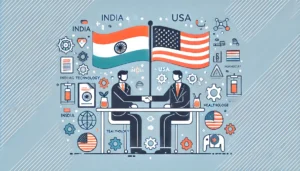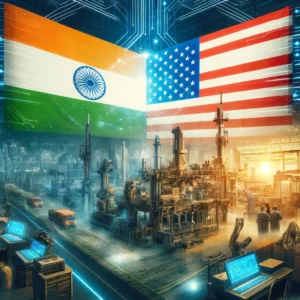US-India Manufacturing Synergies
In an increasingly globalized economy, leveraging international synergies can significantly enhance business prospects. For US entrepreneurs, the Indian economy presents a fertile ground for manufacturing collaborations. With its rapidly growing market, skilled workforce, and supportive government policies, India offers numerous opportunities for strategic manufacturing partnerships. This blog explores the potential synergies between US entrepreneurs and the Indian economy, highlighting key benefits, opportunities, and strategic considerations.
The landscape of global manufacturing is shifting, with companies seeking to optimize their production capabilities by exploring new markets and leveraging international strengths. India, with its robust economic growth and diverse manufacturing sector, stands out as an attractive destination for US entrepreneurs looking to expand their manufacturing footprint. This blog delves into the reasons why India is an ideal partner for US businesses and how such collaborations can lead to mutual growth and innovation.

The Indian Manufacturing Advantage
- Skilled Workforce
India boasts a large and young workforce, with millions entering the job market each year. The country’s emphasis on education and technical training produces a steady stream of engineers, technicians, and skilled laborers. This talent pool is a crucial asset for manufacturing operations, ensuring access to competent and innovative employees who can drive productivity and quality.
- Cost-Effective Production
One of the most compelling reasons for US entrepreneurs to consider manufacturing in India is the cost advantage. Labor costs in India are significantly lower compared to the United States and many other developed countries. Additionally, the cost of raw materials and operational expenses can be more affordable, enhancing overall cost-efficiency. This allows businesses to maintain competitive pricing while maximizing profit margins.
- Government Support and Incentives
The Indian government has implemented a range of policies and incentives to attract foreign manufacturers. Initiatives like “Make in India” aim to transform the country into a global manufacturing hub. These policies offer tax breaks, subsidies, and simplified regulatory procedures. Special Economic Zones (SEZs) and industrial corridors provide further incentives, creating an attractive environment for setting up manufacturing units.
- Strategic Location and Infrastructure
India’s strategic location offers easy access to emerging markets in Asia, Africa, and the Middle East. The country is investing heavily in improving its infrastructure, including roads, ports, and logistics networks. These developments are crucial for efficient manufacturing operations, facilitating the smooth movement of goods and materials across the country and to international markets.
Opportunities for US Entrepreneurs
- Diversified Market Demand
India’s diverse and rapidly growing consumer base presents a wide range of opportunities for manufacturers. The growing middle class is driving demand for various products, from consumer electronics and automobiles to healthcare and lifestyle goods. US entrepreneurs can tap into this market by tailoring their products to meet local preferences and needs.
- Technological Collaboration
Collaboration between US technology and Indian manufacturing can lead to significant innovation. US entrepreneurs can bring advanced technologies and best practices, while Indian manufacturers offer cost-effective production capabilities. This synergy can drive the development of high-quality, innovative products that are competitive in the global market.
- Sustainable Manufacturing
As global awareness of environmental issues grows, there is an increasing demand for sustainable manufacturing practices. India is making strides in this area, with policies promoting renewable energy and eco-friendly technologies. US entrepreneurs can collaborate with Indian partners to implement sustainable practices, reducing their environmental footprint and appealing to environmentally conscious consumers.
Strategic Considerations
- Conduct Thorough Market Research
Understanding the local market is crucial for success. Conducting thorough market research helps identify consumer preferences, market demand, and competitive landscape. This information is vital for making informed decisions and tailoring products to meet local needs.
- Build Strong Local Partnerships
Local partnerships are essential for navigating the complexities of the Indian business environment. Collaborating with local businesses, suppliers, and distributors provides valuable market insights and facilitates smoother operations. These partnerships can also help in navigating regulatory requirements and cultural nuances.
- Invest in Technology and Innovation
Investing in technology and innovation is key to maintaining a competitive edge. US entrepreneurs should leverage advanced manufacturing technologies such as automation, AI, and IoT to optimize production processes, reduce costs, and improve product quality. Innovation in product design and manufacturing processes can also drive growth and competitiveness.
- Focus on Regulatory Compliance
Navigating the regulatory landscape in India can be complex. Ensuring compliance with local laws and regulations, including labor laws, environmental standards, and tax requirements, is crucial. Partnering with local legal experts can help in understanding and adhering to these regulations, avoiding potential legal issues.
Successful Case Studies
Example 1: Boeing’s Manufacturing in India
Boeing has established significant manufacturing operations in India, partnering with local suppliers to produce components for its aircraft. This collaboration leverages India’s skilled workforce and cost-effective production capabilities. Boeing’s investment in India has not only enhanced its global supply chain but also contributed to the development of the local aerospace industry.
Example 2: Ford’s Manufacturing Strategy in India
Ford has strategically positioned India as a key manufacturing hub for its global operations. By setting up production plants in Chennai and Sanand, Ford leverages India’s cost advantages and skilled labor. This has allowed Ford to produce vehicles for both domestic and international markets efficiently, enhancing its competitiveness in the global automotive sector.
Future Prospects
- Emerging Technologies
The role of AI, IoT, and automation in Indian manufacturing is growing rapidly. These technologies enhance efficiency, reduce errors, and enable smart manufacturing practices, making production more agile and responsive to market demands. US entrepreneurs can benefit from integrating these technologies into their manufacturing processes.
- Policy Changes
Potential future policy changes, such as further liberalization of FDI regulations and enhanced infrastructure investments, could significantly impact foreign manufacturers. Staying informed about policy developments is crucial for strategic planning and leveraging new opportunities.
- Market Trends
Anticipated trends in the Indian manufacturing sector include increased adoption of Industry 4.0 practices, a shift towards sustainable manufacturing, and growing demand for high-tech and consumer electronics products. Entrepreneurs should align their strategies with these trends to capitalize on emerging opportunities.
Conclusion
Exploring manufacturing synergies between US entrepreneurs and the Indian economy offers immense potential for growth and innovation. By leveraging India’s skilled workforce, cost-effective production, and government support, US businesses can enhance their global competitiveness. Strategic collaborations, thorough market research, and a focus on technology and sustainability are key to unlocking these opportunities. As India continues to grow as a global manufacturing hub, US entrepreneurs are well-positioned to harness this dynamic economy for mutual success.
Ready to harness the potential of manufacturing in India? Avenue Consumer Brands is your ideal partner in exploring and capitalizing on the synergies between US entrepreneurs and the dynamic Indian economy. With our extensive network, deep market insights, and expertise in regulatory compliance, we ensure a seamless transition and successful operations in India. Let us help you navigate the complexities, optimize your manufacturing processes, and achieve sustainable growth. Contact Avenue Consumer Brands today to start your journey toward global manufacturing success in India!
FAQs
- Why should US entrepreneurs consider manufacturing in India?
India offers cost-effective production, a skilled workforce, and government incentives, making it an ideal manufacturing hub.
- What are the main advantages of India’s workforce for manufacturing?
India provides a large pool of skilled labor, ensuring high productivity and innovation in manufacturing processes.
- How can US businesses start manufacturing in India?
Partnering with local businesses and conducting thorough market research are key steps to successfully start manufacturing in India.

